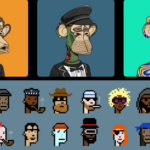With the meteoric rise of NFTs, the demand for NFTs is at an all-time high. While NFTs continue to soar in value and appeal to investors, have you stopped for a minute to consider who created the first NFT? Well, you’re in luck today as we will answer this question and more, further broadening your understanding of the NFT space.
To start with, NFTs were first introduced as Colored Coins. They were first designed for issuance on Bitcoin, a few years before Ethereum was birthed.
As the space continued to evolve, NFT became a more mainstream idea. But with many NFT projects launching every other day, we want to dial back and look at the evolution of NFTs through the years. Here, check out the first NFT projects to shape our current crypto ecosystem.
NFTs: Where did they start from?
The history of NFTs went as far back as 2012 when a paper released by Meni Rosenfield described the NFT technology as “Colored Coins.”
When the idea was conceived, the developer intended to issue “Colored Coins” on the Bitcoin Blockchain. Just so you know, Colored Coins were pitched to investors as a class of methods for representing and managing real-world assets on the Bitcoin blockchain.
However, as smart contracts became a thing and NFT gained more attention, more superior ideas evolved, with Colored Coins fading away. Though Colored Coins never came to fruition, it set the stage for NFTs to thrive.
NFTs: What was the first NFT to be minted?
The first known NFT was minted in 2014, precisely on May 3rd of that year. This NFT project was the brainchild of two leading digital artists, Kevin McCoy and Anil Dash. These digital artists named their NFT Quantum. The NFT was a short video of McCoy’s wife, Jenifer. McCoy went on to mint the video clip on the Namecoin blockchain. To demonstrate that the Quantum NFT had value, he sold it to Dash for $4.
With Quantum now minted, it gave rise to the launch of other NFT projects. For instance, in 2015, another NFT, Etheria was birthed. The NFT was later displayed in DEVCON London, a few months after Ethereum launched.
Following the successful launch of Ethereum, NFTs began to gain even more coverage, especially with the introduction of the ERC-721 standard. This singular move spurred the issuance of NFTs on the Ethereum blockchain.
While 2017 saw the launch of several NFT projects, one of the most notable NFT projects launched at that time was Cryptokitties. This NFT project gave many NFT enthusiasts their first insight into this emerging crypto space.
With more advancement in technology came newer and more exciting NFT projects. Today, many NFT tech have been incorporated into different industries, including the metaverse and gaming industry. As NFT began to find expression in the gaming world, it gave impetus to NFT expansion.
The first NFT project to incorporate gaming theory with NFT is Decentraland. Thanks to Decentraland, gamers could now mint NFT assets within the gaming ecosystem and derive value from them via trade and exchange.
What was the first NFT game?
The first NFT game to be ever launched was Etheria. This NFT game was launched in 2015, giving crypto enthusiasts a glimpse of what the future holds. Etheria seemed to have a similar NFT roadmap to many NFT projects today. For instance, Etheria was designed to allow users to buy digital lands as NFTs.
When Etheria first launched, plots of land within the Etheria NFT ecosystem were sold for as low as one US dollar.
As the NFT gaming space evolved, we began to see more extensive NFT gaming projects, especially with the launch of CryptoKitties. CryptoKitties holds down its spot as the second NFT game to be launched. The project was a game changer, especially in the NFT space as it implemented unique NFT elements into its gaming ecosystem.
Timeline and quick breakdown of the rise of NFTs
To have a solid grasp of the NFT space, it’s important to understand the various timeline that spurred the NFT industry. Let’s look at a quick breakdown of the rise of NFTs.
2012: While it is still a hugely contested topic, many NFT experts believe that the oldest project to set the foundation for the development of NFTs is Colored Coins. This project dates back to 2012 when it was first created on the Bitcoin blockchain. Colored Coins represented real-life assets such as cars and real estate on the blockchain. Unfortunately, due to technical complications and limited knowledge, the project was abandoned. Thankfully, it paved the way for more advancement in NFTs.
2014: This year saw the launch of Counterparty, a decentralized exchange, and asset creator. Like the first NFT project, Counterparty was launched on the Bitcoin blockchain. Even though Counterparty has numerous ideas including trading memes, one thing that was obvious at that time was the inability of the Bitcoin Blockchain to support what the team had in mind.
2014: When it comes to NFT art, Quantum, a brainchild of famous New York digital artist Kevin McCoy is considered to be the first NFT art piece to be ever minted. This NFT was minted on the Namecoin blockchain, before being sold to Dash for only $4. The NFT showcases a pixelated octagon changing color and shape.
2015: While there are a few disagreements as to what the first NFT blockchain game is, most experienced blockchain gamers seem to consider Spells of Genesis, a trading card game to be the first blockchain game. The team partnered with Counterparty to launch the first-ever in-game assets via the Counterparty platform. This in-game asset was called BitCrystals and doubled as the in-game currency for Spells of Genesis.
After the Spells of Genesis came Etheria. While Spells of Genesis was the first blockchain game, Etheria was the first NFT to be launched on the Ethereum network. Etheria kicked off in 2015 and introduced programmable code through smart contracts.
With Ethereum, Etheria developers had the NFT playground they wanted. Basically, Etheria was a virtual game world where owners could own digital assets like hexagonal tiles, buildings, farms, and more. The Etheria NFT was launched a few months after the launch of the Ethereum mainnet.
2016: With more advancement in NFT technologies came new projects including the famous trading card games, Force of Will, and Rare Pepes. These trading games teamed up with Counterparty to deliver new possibilities in the NFT space. Given its impeccable success, Rare Pepes ushered in Crypto Art, with the launch of the first Rare Digital Art Festival. As the year went by, fans began trading them on Ethereum, particularly in 2017, when the network began gaining popularity.
2017: In 2017, CryptoPunks, the most popular OG NFT art collectibles was birthed. The project was created by Larva Labs creators. Without mincing words, CryptoPunks NFTs set the pace and paved the way for generative NFT art projects. When CryptoPunks was launched, it had 10,000 unique NFT art pieces.
Other notable NFT projects launched alongside CryptoPunks include MoonCats and CryptoKitties. To set the record straight, CryptoKitties was a virtual game built on the Ethereum network. The game allowed gamers to adopt, breed, and trade their cats. CryptoKitties generated a lot of buzz and was featured on mainstream news outlets such as Fox News.
On the other hand, MoonCats was an OG NFT collectibles project. Some of its unique selling points include being pixelated. Being a generative art collection, MoonCats featured around 25,600 cats.
When the project first launched, buyers, didn’t know what cat they could get as that could only be revealed upon minting. Because of this, very few people knew about MoonCats. But with the NFT community on Twitter rediscovering the project in 2021, they exploded in fame and price.
Frequently asked questions
Why do people buy NFTs?
Even though there are many reasons for wanting to own an NFT, the two main motives for owning an NFT are investment and pleasure.
Many people in the NFT space today are in it to make money either through flipping NFTs or holding them in their wallets as long-term investments.
Other NFT investors are basically collectors who enjoy buying and holding NFTs in support of an artist or musician they love. For others, holding NFTs gives them a lot of pleasure, especially when they factor in the uniqueness and rarities of their preferred NFT.
Gamers buy NFTs either to make money or upgrade their gameplay experience. Besides the monetary aspect, which is one of the biggest drivers of the NFT industry, many NFT projects are now offering special benefits like utility, merchandise, community benefits, and more. This has spurred more people to invest in NFT projects.
What can you do with an NFT?
Wondering what you can do with an NFT? Well, the list is endless, as NFTs have several use cases. To start with, an NFT is a token associated with a physical or digital product. It is also used to prove the authenticity of ownership. With this analogy, it means that anything can be tokenized into an NFT.
Just so you know, some of the popular use cases for NFTs are art, gaming items, music, digital collectibles, and more. The point of an NFT depends on the user’s perspective. Most people buy NFT-associated items to collect them, make money from them, or receive other utilities such as community benefits.
Overall, there is so much you can do with an NFT. This explains why there is an insane demand for digital collectibles.







